L’ammazone masscherata (1914)

Spanish collectors card by Reclam Film, Mallorca, Card 1 of 6. Photo: Celio Film. Francesca Bertini and Alberto Collo in L'amazzone mascherata/The Woman Who Dared (Baldassarre Negroni, 1914). The Spanish release title was La Amazona disfrazada.
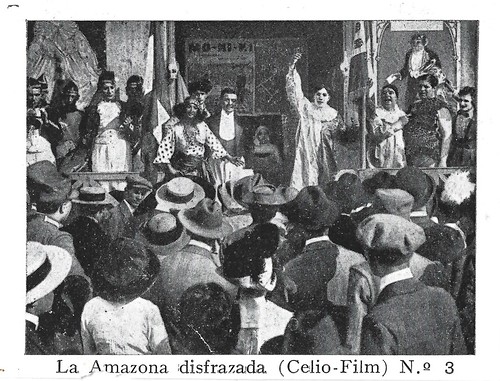
Spanish collectors card by Reclam Film, Mallorca, Card 3 of 6. Photo: Celio Film. Leda Gys (the coloured woman with the black curls in the back) in L'amazzone mascherata/The Woman Who Dared (Baldassarre Negroni, 1914). The moment of this card lacks in the existing film print.
Disguised as The Masked Amazon
Countess Franca de Roberti (Francesca Bertini), the toast of high society, plans a charity fete with herself as a splendid rider at the travelling circus Sterosky. The louche circus manager Jean Sterosky (Emilio Ghione), however, is a spy, who with his aid, the coloured girl Nadia (Leda Gys), spies for the neighbouring country Silistria. Knowing that Franca's husband, Count Albert (Alberto Collo), is in possession of precious military documents, they lure him to a restaurant and drug him.
Sterosky steals secret mobilisation documents on the cavalry plans from Albert's safe in his house and delivers these to the prime minister of the hostile power, for a huge award. That night, Franca is a huge success as a rider at the circus, but the next day Albert discovers the plans are gone from his safe. He meets his general to communicate the loss. Albert is arrested and sentenced to two years in prison. Countess Franca is prostrated by her husband's disgrace, but confident of his innocence sets herself to find evidence which will set him free. A button with the initials J.S., found by her servant Alexis (Amedeo Ciaffi), leads her to suspect that Sterosky is the real thief of the plans. She looks for help from her lawyer (Angelo Gallina) but he is powerless, so she takes things into her own hands.
Disguised as The Masked Amazon, Franca joins the circus and soon becomes a sensation, including in Silistria, even if remaining a mystery to anyone but her butler Alexis. He locates Sterosky's divorced wife, Nadia, and from her they learn that the spy is in the city, living the high life thanks to the payment for his theft. Several days, from his box at the hippodrome, Sterosky is struck with the grace of the masked rider and asks for an introduction, which is granted.
The countess, never taking off her mask, leads him on until he invites her to take dinner in his room. She accepts, and as they are dining suddenly removes her mask and covers him with a revolver. She forces him to give her the plans and his correspondence with the Silistrian officials and is delighted to find that the papers prove her husband's innocence. Still covering Sterosky with the pistol, she makes her escape from the house. In her haste, she drops one of the documents, but Alexis, whom she has left on guard at the door, picks it up and jams it into his pocket.
Now that she has the precious proofs, the countess loses no time in leaving the Silistrian capital. Sterosky, however, has not lost his presence of mind and succeeds in getting a warrant for her arrest. He charters a high-powered motor car and starts for the border at top speed. There is an exciting race between his machine and the train which bears the countess. The auto wins, and when the daring woman reaches the frontier, Sterosky and a squad of the military police are waiting for her at the border station. The papers are taken from her and she is hustled across the border into her own country. She returns heartbroken to her home. Several days later, Alexis, who has followed on another train, arrives and gives her the paper which she dropped in fleeing from Sterosky's house. It proves to be a letter from the prime minister of Silistria to the spy and conclusively proves the innocence of the count. This letter turned over to the military authorities, wins a pardon for Albert and brings back happiness to the woman who dared.

Spanish collectors card by Reclam Film, Mallorca, Card 4 of 6. Photo: Celio Film. Francesca Bertini, Leda Gys and Amedeo Ciaffi in L'amazzone mascherata/The Woman Who Dared (Baldassarre Negroni, 1914). The moment of this card lacks in the existing film print.
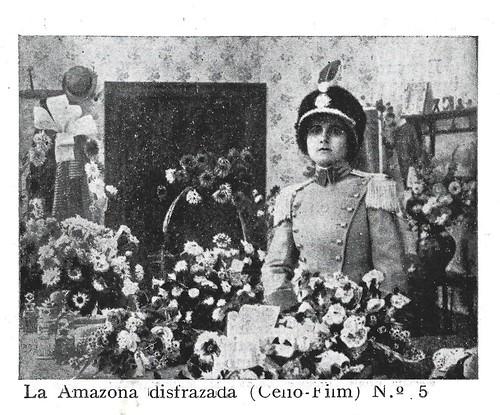
Spanish collectors card by Reclam Film, Mallorca, Card 5 of 6. Photo: Celio Film. Francesca Bertini in L'amazzone mascherata/The Woman Who Dared (Baldassarre Negroni, 1914).
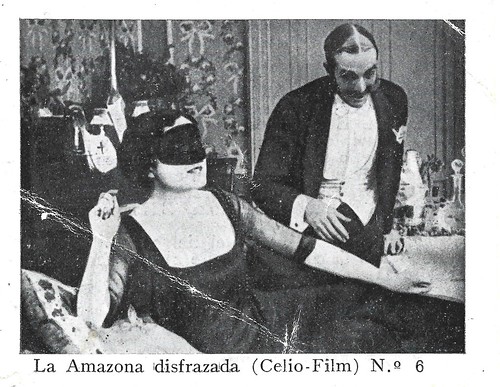
Spanish collectors card by Reclam Film, Mallorca, Card 6 of 6. Photo: Celio Film. Francesca Bertini and Emilio Ghione in L'amazzone mascherata/The Woman Who Dared (Baldassarre Negroni, 1914).
Nelly la gigolette (1915)

Spanish collectors card by Reclam Film, Mallorca, Card 2 of 6. Photo: Caesar Film / Urgui. Francesca Bertini in Nelly la gigolette (Emilio Ghione, 1915). The Spanish release title was Nelly, la bailarina de la taberna negra.
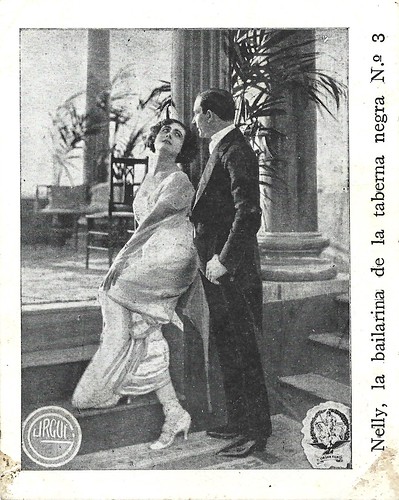
Spanish collectors card by Reclam Film, Mallorca, Card 3 of 6. Photo: Caesar Film / Urgui. Francesca Bertini and Alberto Collo in Nelly la gigolette (Emilio Ghione, 1915).
Revenge with equal, yet feminine cruelty
Francesca Bertini plays Nelly, the dancer of the Black Tavern (the alternative title of the film). She is the girl, the gigolette, of the Apache Zar-la-Mort (Emilio Ghione), a notorious man of the Parisian underworld.
Nelly is forced by him to seduce the rich banker Albert (Alberto Collo), so that Zar can rob him of everything. Yet, Nelly falls in love with Albert, confesses the crime and repairs the wronging, fleeing with Albert to America.
But even there they cannot escape the wrath of Zar, who tracks them down, kills Albert and forces Nelly to return with him to Paris. With equal, yet feminine cruelty, Nelly will take revenge...
Allan Kardec wrote in L'Alba cinematografica: "Her every muscle quivers and vibrates in the revelation of her soul: it is enough to watch her movements for even the most layman to understand the feelings that animate the character."
Despite serious cuts by the Italian censor, the film was an enormous success and caused Ghione to make a whole series of films on Za-la-Mort (now with one -r less). The film had its Roman premiere on 5 January 1915. It was Bertini's first film at Caesar Film. Unfortunately, as far as we know, Nelly la gigolette is a lost film.

Spanish collectors card by Reclam Film, Mallorca, Card 4 of 6. Photo: Caesar Film / Urgui. Francesca Bertini and Alberto Collo in Nelly la gigolette (Emilio Ghione, 1915).
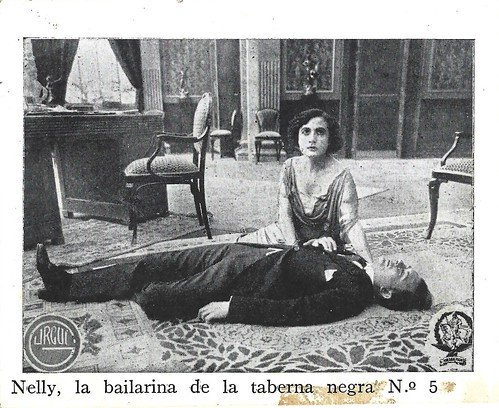
Spanish collectors card by Reclam Film, Mallorca, Card 5 of 6. Photo: Caesar Film / Urgui. Francesca Bertini in Nelly la gigolette (Emilio Ghione, 1915). The man could be Alberto Collo.

Spanish collectors card by Reclam Film, Mallorca, Card 6 of 6. Photo: Caesar Film / Urgui. Francesca Bertini in Nelly la gigolette (Emilio Ghione, 1915). The man could be Alberto Collo.
Nerone e Agrippina (1914)

Spanish collectors card by Reclam Films, Mallorca, card 1 of 6. Photo: Gloria Film. Nerone e Agrippina (Mario Caserini, 1914), starring Vittorio Rossi Pianelli as Nerone and Maria Caserini as Agrippina. Nero's banquet.
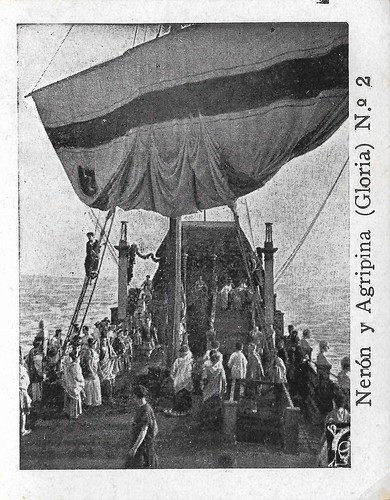
Spanish collectors card by Reclam Films, Mallorca, card 2 of 6. Photo: Gloria Film. Nerone e Agrippina (Mario Caserini, 1914), starring Vittorio Rossi Pianelli as Nerone and Maria Caserini as Agrippina. The first attempt to murder Agrippina at the instigation of Nero happens on a ship, but she survives, to the great anger of her son.

Spanish collectors card by Reclam Films, Mallorca, card 3 of 6. Photo: Gloria Film. Nerone e Agrippina (Mario Caserini, 1914), starring Vittorio Rossi Pianelli as Nerone and Maria Caserini as his dead mother, Agrippina.
When a disastrous fire destroys Rome in 64 A.D.
Claudius (Emilio Petacci), having succeeded Caligula who was assassinated by the Praetorians, recalls Agrippina (Maria Caserini), his niece, from exile and she begins to plot to make her son Nero (Vittorio Rossi Pianelli) emperor. She has Messalina killed, then seduces her uncle into marrying her and appoints Nero as heir instead of his son Britannicus (Gian Paolo Rosmino). Claudius dies of poisoning and Nero becomes emperor, but Agrippina pretends to dictate to him as well and threatens to put Brittanicus on the throne. Nero therefore first poisons Brittanicus and then has Agrippina killed herself by Tigelinus (Dante Cappelli). Nero then begins to show increasing signs of mental derangement.
Because of this, many, including the philosopher Seneca (Telemaco Ruggeri), think to get rid of him, but Nero discovers the conspiracy and forces him to commit suicide. When a disastrous fire destroys Rome in 64 A.D., the people blame Nero, who, instigated by Poppaea (Lydia De Roberti), reacts by pointing to the Christians as the culprits and begins the persecution into which St Paul also falls. During a feast, Nero kills Poppaea, who is pregnant and goes completely mad. The reconstruction of burnt-out Rome resulted in the construction of the Domus Aurea. After another four years, the army, tired of Nero's follies, revolts: Galba marches on Rome and proclaims himself emperor. Nero flees to the places of his youth, where he finds Actae (Fernanda Sinimberghi), whom he loved in his youth and who is now a Christian and is killed by a former slave.
Nerone e Agrippina/Nero and Agrippina (Mario Caserini, 1914) was produced by Gloria Film as a result of a decision by which the Turin-based company renounced a new version of The Last Days of Pompeii (Eleuterio Rodolfi, 1913), which it had announced it would make since April 1913, using 10 lions, 50 horses, 1,000 extras, with scenes from life at the foot of Vesuvius and for a final product of 3,000 metres of film. This decision was caused by the fact that two competing companies - Ambrosio and Pasquali - had both distributed their own film version of Bulwer-Lytton's novel, opening a season of court cases and heated polemics and accusations of the 'indecent and unfair collaboration' that characterised the film industry at that time.
Gloria, which at that very time was reaping the worldwide success decreed to the first diva film Ma l'amor mio non muore (Mario Caserini, 1913) with Lyda Borelli, decided to escape these dynamics. However, several scenes had already been shot in the Arena di Verona, the use of which had been obtained following a generous donation to the Congregazione di Carità del Comune scaligero. Given the importance and commitment of the filming, which began at the end of October 1913 and was entrusted to two cameramen, the Turin-based company had lined up its entire artistic staff, both by flanking two expert directors such as Alberto Degli Abbati and Giuseppe de Liguoro under the direction of Mario Caserini and by employing the entire team of actors and actresses at its disposal. The scenes already filmed in Verona were then reused for a new 'Kolossal' that was, in fact, Nero and Agrippina. Other scenes were realised in the winter of 1913 at the studio that Gloria had taken over in Pegli (at that time still an autonomous municipality with respect to Genoa), in order to make use of the best climatic and lighting conditions existing near the sea. A pier was built on the beach of the seaside resort and two triremes were equipped for the scene of Agrippina's embarkation. The scenes of the burning of Rome were instead realised near Turin with specially erected constructions.
Even with regard to the new film, divided into 10 parts and partly inspired by Boito's Nerone, Gloria announced that it had wanted to do things on a grand scale, employing "more than 100 first-rate artists, a troop of male & female slaves, circus scenes and nautical festivals, imperial villas and palaces and splendid costumes". Nor did the production effort fail at the film's distribution stage, as the film was accompanied by 'colourfully painted posters, 72 medium-format stills, 30 large-format 60 x 80s, a colour illustrated booklet and two musical scores, one for small and the other for large orchestras'. This rush to the productive effort of the Italian film industry - which was to enter a crisis a few months later due to the outbreak of war - was criticised by those who claimed that "until two years ago with 2-300,000 lire one could still open a good film studio, while today half a million is spent on a single film [such as] 'Gloria', whose Nerone has so far cost 400,000 Francs."
Nero and Agrippina was presented on 20 March 1914 at the 'Borsa' cinema in Turin in a private viewing reserved for dignitaries, intellectuals, also from abroad, and with members of the Savoy royal family in attendance, receiving much applause at the end of each part. There were the premises for a new international success for Gloria' which concluded "at a very high price" an agreement with Pathé for the distribution of the film in the USA, Canada, Belgium, the Netherlands, France, Switzerland, Turkey and non-Austrian Balkan countries, while in Germany and Great Britain plus relative colonies distribution was direct. But the film's progress was first overshadowed by the release, only two weeks later, of Cabiria and, a few months later, by the outbreak of war, which effectively blocked international trade. Meanwhile, with Caserini's departure, Gloria Film had also entered a waning phase. In the face of the substantial production investment, therefore, Nero and Agrippina was considered a commercial failure.
The few commentaries available provide enthusiastic descriptions of the film, so much so that one critic of the time wrote of "a film so perfect that it eludes true critical examination. Everything is carefully studied and meticulously executed: [it is] a masterpiece that begins its triumphant 'tour' around the world'. Even the British periodical, The Bioscope, called it 'a masterpiece' on 16 April 1914. Believed to be lost for a long time, Nero and Agrippina was fortunately found again in July 1999 by some Italian scholars who were carrying out research at the "Norsk Film Institute" in Oslo, to whom we also owe the subsequent restoration of the remaining 1,850 metres of the film (around 84 minutes) compared to the original 2,000. NB Many sources list Caserini as director or co-director of the 1913 Ambrosio version of Gli ultimi giorni di Pompei (Eleuterio Rodolfi, 1913), but this is a stubborn error which keeps popping up.
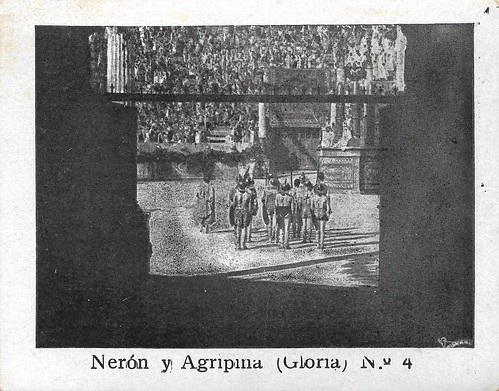
Spanish collectors card by Reclam Films, Mallorca, card 4 of 6. Photo: Gloria Film. Nerone e Agrippina (Mario Caserini, 1914), starring Vittorio Rossi Pianelli as Nerone and Maria Caserini as Agrippina. The gladiators enter the arena, greeting the emperor: "Ave Caesar, morituri te salutant" (Greetings, Caesar, those who are about to die, salute you).
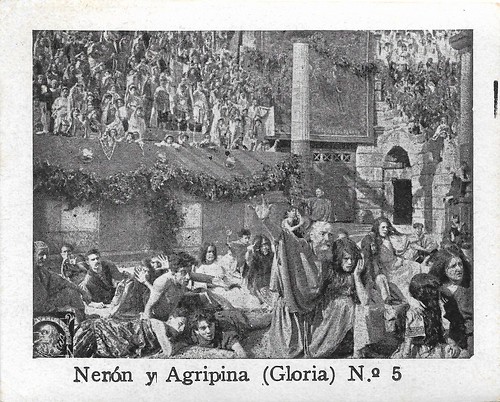
Spanish collectors card by Reclam Films, Mallorca, card 5 of 6. Photo: Gloria Film. Nerone e Agrippina (Mario Caserini, 1914), starring Vittorio Rossi Pianelli as Nerone and Maria Caserini as Agrippina. Persecution of the Christians in the arena.
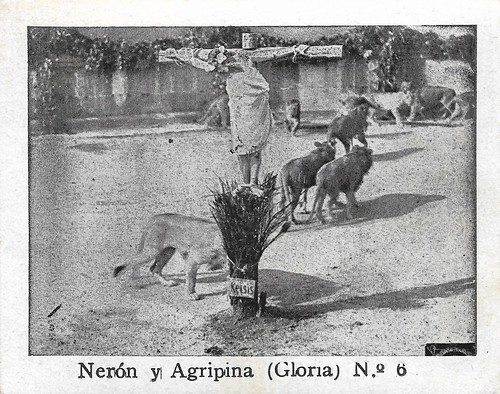
Spanish collectors card by Reclam Films, Mallorca, card 6 of 6. Photo: Gloria Film. Nerone e Agrippina (Mario Caserini, 1914), starring Vittorio Rossi Pianelli as Nerone and Maria Caserini as Agrippina. Persecution of the Christians in the arena.
Il rubino del destino (1914)

Spanish collectors card (minicard) by Chocolate Amatller, Barcelona, no. 1 of 6. Photo: Milano Films. Mercedes Brignone, Franz Sala and Livio Pavanelli in Il rubino del destino/The Ruby of Destiny (Henri Étiévant, 1914), scripted by Augusto Genina. The film was released in Spain as El rubí del destino in January 1914.

Spanish collectors card (minicard) by Chocolate Amatller, Barcelona, no. 2 of 6. Photo: Milano Films. Mercedes Brignone and Livio Pavanelli in Il rubino del destino/The Ruby of Destiny (Henri Étiévant, 1914), scripted by Augusto Genina.

Spanish collectors card (minicard) by Chocolate Amatller, Barcelona, no. 3 of 6. Photo: Milano Films. Mercedes Brignone, Franz Sala and Livio Pavanelli in Il rubino del destino/The Ruby of Destiny (Henri Étiévant, 1914), scripted by Augusto Genina.
A legendary ruby that protects the royal bloodline
When King Constantine dies, his daughter Luise becomes Queen of Styr. She appoints Lieutenant Eric (Livio Pavanelli) as her personal guard. Luise is in love with the handsome lieutenant but doesn't know he instead loves her sister Luitza (Mercedes Brignone).
Count Tiarko (Franz Sala), also in love with Luitza, tries with all means to separate Luitza and Eric. He orders his crony Walton to steal a ruby that according to an old legend protects the royal bloodline, and places the guilt on Eric.
The Queen, unsuspecting, orders Tiarko to find the ruby and promises her sister's hand in return. Eric is condemned to death but Luitza manages to let him escape. Eric moves to Milan, where Tiarko has hidden the jewel, but where it is stolen from him by the adventuress Paola (Thea Sandten). After many more troubles, Tiarko will perish and Eric and Luitza can marry.
Sources disagree about who's who in this film. In his credit list Vittorio Martinelli, in Il cinema muto italiano, Vol. 1914, part 2, conflates the two sisters into one Queen Luitza played by Brignone. Our cards seem to contest that the queen is played by Brignone, but the low resolution of the card doesn't help in identifying Brignone as the sister.
IMDb claims Pavanelli played Styr, the investigator, but the kingdom is named Styr. Yet, the man in civilian clothes demonstrating the found ruby may well be a detective. One of our cards even suggests it is he who gets the hand of the sister in the end, and not the lieutenant, in contrast to the plot given above.

Spanish collectors card (minicard) by Chocolate Amatller, Barcelona, no. 5 of 6. Photo: Milano Films. Scene from Il rubino del destino/The Ruby of Destiny (Henri Étiévant, 1914), scripted by Augusto Genina.

Spanish collectors card (minicard) by Chocolate Amatller, Barcelona, no. 6 of 6. Photo: Milano Films. Mercedes Brignone and Livio Pavanelli in Il rubino del destino/The Ruby of Destiny (Henri Étiévant, 1914), scripted by Augusto Genina.
Amore e cospirazione (1915)
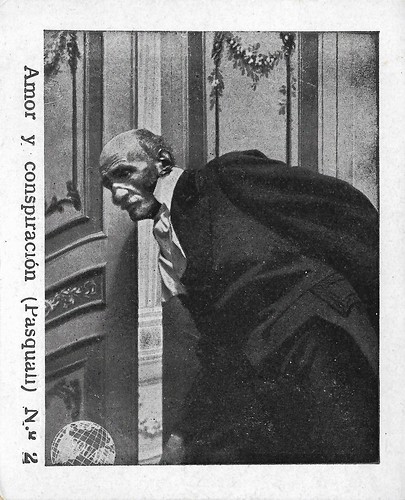
Spanish collectors card (minicard) by Reclam Films, Mallorca, no. 2 of 6. Photo: Pasquali Films. Scene from Amore e cospirazione (Enrico Vidali, 1915). One of the servants overhears a conversation.

Spanish collectors card (minicard) by Reclam Films, Mallorca, no. 3 of 6. Photo: Pasquali Films. Scene from Amore e cospirazione (Enrico Vidali, 1915). The man right in the foreground is Alberto Capozzi, looking guilty while kneeling on his side is Maria Gandini. The man on the extreme left is director Enrico Vidali himself.
The Italian press thought this film quite outdated
Little is known about the plot of Amore e cospirazione (1915) by Enrico Vidali, but it is clear there is a conflict between the fight against the Austrian oppressor and the love of a man and a woman and this is set during the Italian Risorgimento.
While Vidali and Maria Gandini had been protagonists of the popular Pasquali version of Gli ultimi giorni di Pompei/The Last Days of Pompeii (Eleuterio Rodolfi, 1913), Alberto Capozzi had been an enormous star at Ambrosio in the early 1910s. However, by 1915 the Italian press thought this film quite outdated and claimed the audience thought so too.
Yet, during the First World War, many historical films were made in Italy that boosted the war morale against Austria, e.g. Emilio Ghione's films for Tiber Film, such as Guglielmo Oberdan, il martire di Trieste/Guglielmo Oberdan, the martyr of Trieste (Emilio Ghione, 1916).

Spanish collectors card (minicard) by Reclam Films, Mallorca, no. 4 of 6. Photo: Pasquali Films. Scene from Amore e cospirazione (Enrico Vidali, 1915). On the right, Enrico Vidali is the evil antagonist, working for the Austrian occupying army, and ordering an arrest.

Spanish collectors card (minicard) by Reclam Films, Mallorca, no. 6 of 6. Photo: Pasquali Films. Scene from Amore e cospirazione (Enrico Vidali, 1915). On the right are the two main actors: Alberto Capozzi embracing Maria Gandini. On the extreme left is Enrico Vidali.
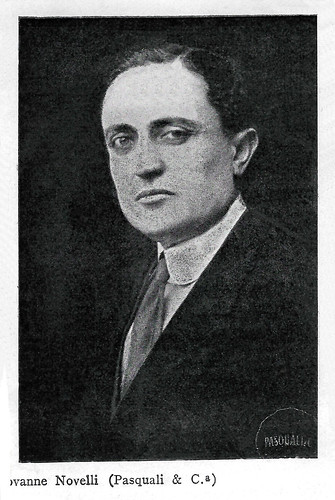
Spanish minicard. Photo: Pasquali & Cie. Giovanni Enrico Vidali, here presented as Giovanni Novelli.
Sources: Vittorio Martinelli (Gianfranco Mingozzi, 'Francesca Bertini'), Vittorio Martinelli (Il cinema muto italiano, Vol. 1914, part 2), and IMDb.
No comments:
Post a Comment